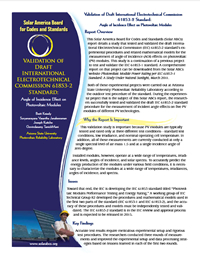
Validation of Draft International Electrotechnical Commission (IEC) 61853-2 Standard: Angle of Incidence Effect on Photovoltaic Modules
Download the one-page summary (PDF, 424KB) or the full report (PDF, 2.17MB).
Overview

This Solar America Board for Codes and Standards (Solar ABCs) report details a study that tested and validated the draft International Electrotechnical Commission (IEC) 61853-2 standard's experimental procedures and related mathematical models for the measurement of angle of incidence effects on photovoltaic (PV) modules. This study is a continuation of a previous project to test and validate the IEC 61853-1 standard. A comprehensive report on that project can be downloaded from the Solar ABCs website (Photovoltaic Module Power Rating per IEC 61853-1 Standard: A Study Under Natural Sunlight, March 2011).
Both of these experimental projects were carried out at Arizona State University Photovoltaic Reliability Laboratory according to the outdoor test procedure of the standard. During the experimental project that is the subject of this Solar ABCs report, the researchers successfully tested and validated the draft IEC 61853-2 standard procedure for the measurement of incident angle effects on five PV modules of different PV technologies.
Why the Report is Important
This validation study is important because PV modules are typically tested and rated only at three different test conditions—standard test conditions, low irradiance, and nominal operating cell temperature. In addition, all of these measurements are currently conducted at only a single spectral level of air mass 1.5 and at a single incidence angle of zero degree.
Installed modules, however, operate at a wide range of temperatures, irradiance levels, angles of incidence, and solar spectra. To accurately predict the energy production of the modules under various field conditions, it is necessary to characterize the modules at a wide range of temperatures, irradiances, angles of incidence, and spectra.
Issue
Toward that end, the IEC is developing the IEC 61853 standard titled "Photovoltaic Modules Performance Testing and Energy Rating." A working group of IEC Technical Group 82 developed the procedures and mathematical models used in the first two parts of the standard (IEC 61853-1 and IEC 61853-2), and the accuracy of these procedures and models must be independently tested and validated. The IEC 61853-2 standard is in the IEC review and approval process and is expected to be released in 2015.
Key Findings
Accurate test results require meticulous experimental setup and rigorous test procedures. The researchers conducted three rounds of measurements and improved the experimental setup and data processing strategies based on lessons learned in each of the first two rounds.
Test results show nearly identical relative light transmission plots for all five test modules with glass superstrate regardless of the type of PV cell technology. (This project tested monocrystalline silicon, polycrystalline silicon, amorphous silicon, cadmium telluride, and copper indium gallium selenide). This indicates that the reflective losses are governed almost exclusively by the air-glass interface of the PV modules.
The relative light transmission plots obtained using the IEC 61853-2 model were in good agreement with the plots obtained using the theoretical air-glass interface models and the empirical model developed by Sandia National Laboratories for the glass superstrate PV modules.
The standard states that "for the flat glass superstrate modules, the AOI test does not need to be performed, rather, the data of a flat glass air interface can be used." The results obtained in the current study validate this statement.